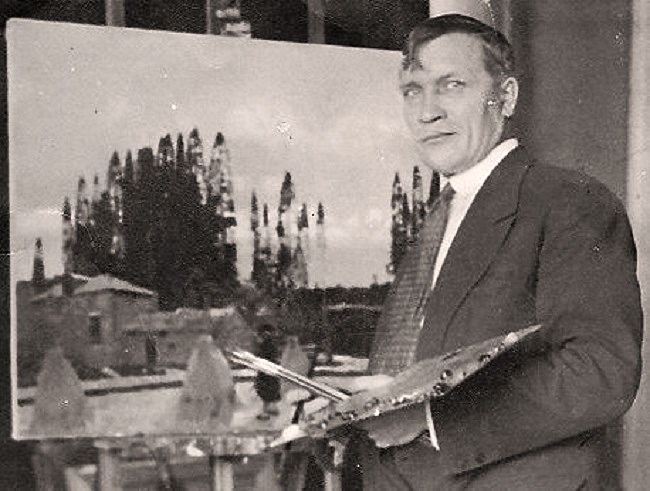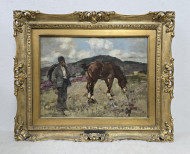- Home
- Isupov Aleksei - artist, representative of salon painting
Isupov Aleksei - artist, representative of salon painting

Aleksey Isupov: A Realist Artist with an Italian Accent
Aleksey Vladimirovich Isupov (1889–1957) was a distinguished Russian realist painter and a prominent representative of salon painting, whose life and work were closely intertwined with Russia, Central Asia, and Italy. His works, imbued with a profound sense of color and light, are housed in major museums worldwide, including the State Tretyakov Gallery and the Uffizi Gallery.
Early Years and Artistic Development
Aleksey Isupov was born on March 10, 1889, in Vyatka (now Kirov), into the family of an iconostasis master. From childhood, he was immersed in the world of art, studying in an icon painting workshop and participating in art exhibitions in his hometown as early as 1903.
In 1908, Isupov enrolled in the renowned Moscow School of Painting, Sculpture and Architecture, where his mentors included pillars of Russian painting such as A. E. Arkhipov, A. M. Vasnetsov, K. A. Korovin, V. A. Serov, and S. V. Malyutin. His years of study (until 1912) were marked by active participation in exhibitions of the Union of Russian Artists and the Association of Traveling Art Exhibitions, as well as displays at Moscow's Lemercié Gallery and the Spring Exhibitions of the Imperial Academy of Arts. In 1913, after marrying Tamara Ivanova, Isupov journeyed along the Volga River and to Crimea, and later traveled through the Urals, drawing inspiration from Russian nature.
War Years and Central Asian Period
With the outbreak of World War I in 1915, Aleksey Isupov was mobilized into the army and served in Turkestan, in Tashkent. Despite the wartime conditions, he continued to paint. After being demobilized for health reasons in late 1917, the artist briefly returned to Moscow and Vyatka, but by May 1918, he was back in Tashkent.
In Central Asia, Isupov actively participated in cultural life: he taught at the Turkestan Regional People's Art School, illustrated books, and engaged in artistic design. In 1920, commissioned by the People's Commissariat of Education of the RSFSR, he moved to Samarkand, where he headed the art section of the Commission for the Restoration and Protection of Monuments. During this period, he deeply studied the archaeology, history, and culture of Central Asia, creating plein-air, impressionistic oriental landscapes and genre scenes such as "Uzbeks in a Teahouse," "In Old Turkestan," and "Samarkand."
Return to Moscow and the Italian Chapter
In 1921, Isupov returned to Moscow, where he joined the Association of Artists of Revolutionary Russia (AKhRR). He continued to exhibit and create works on revolutionary themes, including a series of portraits of Soviet statesmen and paintings dedicated to events of the Civil War. Commissioned by AKhRR, he worked on the painting "V. I. Lenin Playing Chess," and his work "Farewell to Lenin in the Hall of Columns" (1926) was dedicated to the leader's funeral. Isupov also played an important role in establishing the Vyatka City Historical and Art Museum, donating his painting "Northern Landscape" to its collection. In 1924–1925, his works were successfully exhibited in the United States.
In 1926, Aleksey Isupov left Russia and moved with his family to Italy. The official reason for his assignment was to fulfill a commission from the All-Union Central Council of Trade Unions, but the true reason was the worsening of an incurable joint disease (bone tuberculosis). Despite his longing for his homeland and dreams of returning, serious health problems kept him in Italy for over thirty years.
In Rome, Isupov gained immediate recognition. He was drawn to various genres—from still life and animal painting to portraiture, at which he particularly excelled, becoming a popular portraitist. Italian critics and artists highly praised his "broad brushstrokes, subtle analysis of details, and pursuit of truth," as well as the "tender colors" and "truth and poetry" that the public found in his works. Isupov's exhibitions were held in Rome, Milan, Naples (where Maxim Gorky visited him), as well as in The Hague, Livorno, Genoa, Florence, Bergamo, Trieste, Turin, France, Holland, and Belgium.
During World War II, the artist actively supported the Italian Resistance, turning his studio into a safe house. After the war, in 1945, a major solo exhibition of his work took place at the Gallery of Modern Art in Rome, and in 1949, an illustrated monograph on his art was published, written by the renowned Italian art critic Giorgio Nicodemi.
Legacy and Remembrance
Aleksey Vladimirovich Isupov never considered himself an emigrant, remaining a Soviet citizen. He passed away on July 17, 1957, in Rome and was buried in the Non-Catholic Cemetery in Testaccio, alongside other distinguished Russian artists.
Fulfilling her husband's will, in 1958, his widow Tamara Nikolaevna Isupova brought a significant part of his legacy back to Russia: approximately 300 works (80 paintings and over 200 drawings) were donated to the Vyatka Art Museum, which Isupov himself had helped found. Nineteen works were added to the collection of the State Tretyakov Gallery.
Aleksey Isupov's work continues to generate widespread interest. His pieces were exhibited at the Academy of Arts (1968), and the first solo exhibition in the USSR took place in Kirov (1971), followed by Moscow (1973), Riga, and Tashkent (1977). In 2009, the Tretyakov Gallery hosted a major monographic exhibition, "Aleksey Isupov. Russia – Italy," and in 2013, the exhibition traveled to Kirov and Yoshkar-Ola. In 2020, three of his works were featured at the Garage Museum of Contemporary Art.
Aleksey Isupov's works adorn the collections of many European museums, including the Uffizi Gallery in Florence, the National Gallery of Modern Art in Rome, and museums in Milan, Naples, Uzbekistan, and the United States.
Sales of paintings by Alexey Isupov at auctions:
- Christie's (London, United Kingdom)
- Goldens (Kyiv, Ukraine)
- 30
- 60
- 90







